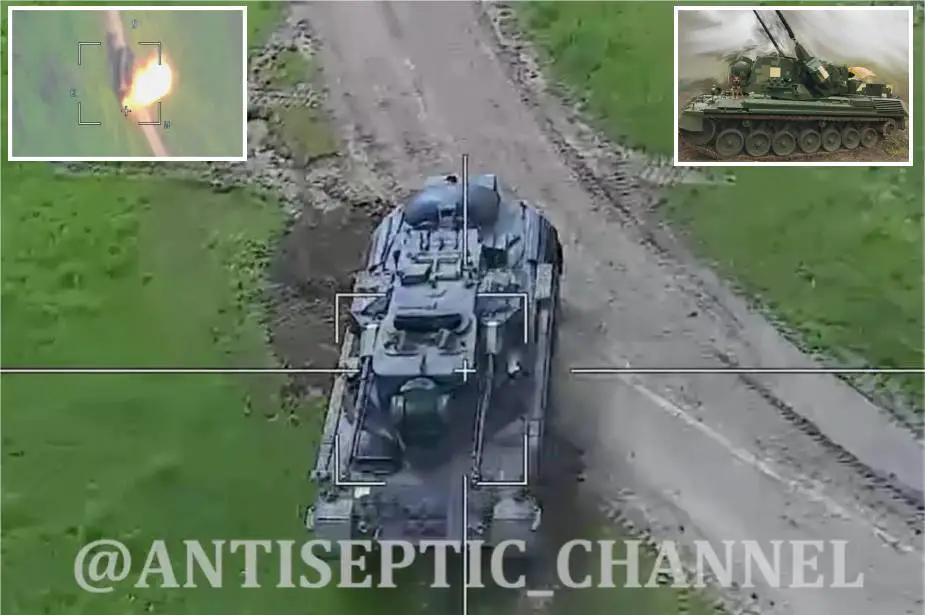- Army
- Conflicts in the world
- Israel - Iran conflict 2025
- Pakistan - India Conflict 2025
- Russia Ukraine War 2022
- Libya conflict day by day
- HAMAS - Israel War 2023
- Operation Serval in Mali French Army
- Sangaris operation Central African Republic
- Sangaris opération militaire République Centreafrique
- Ukraine - Russia conflict
- Syria conflict news
- Defence & Security Industry Technology
- Armies in the world
- Analysis Defense and Security Industry
- Conflicts in the world
- Navy
- Air
Russians destroy first German Gepard anti-aircraft gun system in Ukraine with Lancet drone
According to a video released on the Russian Social Network VK on April 28, 2023, using a Lancet loitering munition, Russian soldiers have destroyed the first Gepard 35mm self-propelled anti-aircraft gun system donated by Germany to the Ukrainian army. Today, the use of Lancet loitering munition against modern equipment combat vehicles donated by the United States and NATO allies is a priority for the Russian armed forces.
Follow Army Recognition on Google News at this link

Russian army destroys first Gepard 35mm anti-aircraft gun systems using Lancet loitering munition. (Picture source video footage from VK Social Network)
A Lancet loitering munition is a type of unmanned aerial vehicle (UAV) designed for use as a loitering weapon system. Loitering munitions, also known as "kamikaze drones" or "suicide drones," are designed to loiter over a battlefield or a target area, search for enemy targets, and engage them with precision strikes. These munitions are typically smaller and more agile than traditional UAVs, and they often have a relatively short operational range.
The "Lancet" loitering munition is a Russian-developed UAV (unmanned aerial vehicle) system designed for surveillance, reconnaissance, and strike missions. Developed by the company ZALA Aero, which is part of the Kalashnikov Concern, the Lancet has been showcased in multiple military exhibitions and forums, such as the Army-2019 international forum.
There are different versions of the Lancet, with the Lancet-3 being the most well-known. The Lancet-3 is equipped with a high-explosive fragmentation warhead and is designed to loiter over a target area, detect enemy targets, and engage them with precision strikes. The system has a range of up to 40 kilometers (24.8 miles) and an endurance of up to 40 minutes.
The Lancet-3 features a compact design, making it relatively easy to transport and deploy. It is launched from a portable catapult system and can be operated by a single person with a ground control station. The loitering munition is equipped with a variety of sensors, including electro-optical and infrared systems, to detect and identify targets. Once a target is detected and verified, the Lancet-3 can be commanded to dive towards the target and detonate its warhead, causing damage or destruction.
Loitering munitions provide significant value when employed against armored vehicles due to their unique capabilities and characteristics. It is equipped with advanced sensors, such as electro-optical and infrared systems, that enable them to accurately identify and engage armored vehicles. This precision allows for the effective neutralization of specific high-value targets while minimizing collateral damage.
The ability to loiter over the battlefield and engage targets at unexpected moments can catch enemy forces off-guard. This element of surprise can be especially effective against armored vehicles that may be more vulnerable when stationary or during the process of redeployment.
Loitering munitions are generally smaller and cheaper than traditional guided missiles, making them a cost-effective solution for engaging armored vehicles. Additionally, their relatively low cost allows for the deployment of multiple munitions, which can increase the probability of mission success

The Gepard is a German-made anti-aircraft guns system based on a Leopard 1 tank tracked chassis armed with two 35mm cannons. (Picture source Wikimedia)
According to a list published by the German Ministry of Defense, Ukrainian armed forces have received 34 Gepard 35mm self-propelled anti-aircraft gun systems since the beginning of the war in Ukraine.
The Gepard, or Flakpanzer Gepard, is a German self-propelled anti-aircraft gun (SPAAG) developed during the late 1960s and early 1970s. It was designed to provide mobile air defense for ground forces and protect them from low-flying aircraft, helicopters, and unmanned aerial vehicles (UAVs). The Gepard is built on the chassis of the Leopard 1 main battle tank and features a turret-mounted dual 35mm Oerlikon KDA autocannon system, which has an effective range of approximately 4,000 meters (13,123 feet) and a firing rate of 550 rounds per minute per gun.
The advanced fire control system of the Gepard includes radar, electro-optical, and infrared sensors, enabling it to effectively track and engage targets in various weather conditions and at different times of the day. Its mobility is excellent due to being built on the Leopard 1 chassis, which allows it to keep pace with other armored units and quickly reposition in response to changing battlefield conditions.
Over the years, several variants of the Gepard have been developed, including upgraded versions with improved radar systems and other enhancements. Although the Gepard 35mm has been retired from service in the German Bundeswehr, it remains in use by several other countries and continues to be a potent short-range air defense platform.


























